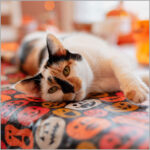Cat lovers around the world are captivated by the sheer variety in feline appearances, especially the stunning array of coat colors. From the sleekest black panther look-alikes to the fluffiest ginger marmalades, the Colors Of Cats are truly a spectacle of nature. It’s amazing to think that this vast spectrum of beautiful coats arises from a surprisingly simple genetic foundation. Believe it or not, at their core, all cats are genetically programmed to be either black or orange!
This fascinating diversity in cat colors is a result of genetic modifications, much like using filters on a photo editing app. These genes act upon the underlying “base colors,” creating the breathtaking and unique coat patterns we admire in our feline companions. Let’s delve into the genetics behind these colors and unravel the secrets of how your kitty got their gorgeous coat!
Black or Orange: The Foundational Colors of Cats
It might sound unbelievable, but it’s a fundamental truth in feline genetics: there are only two base colors for cat coats – black and orange. At a genetic level, every cat is fundamentally either black, orange, or a combination of both.
 A close-up shot of a tortoiseshell cat's face, showcasing the intermingled patches of black and orange fur. The cat has green eyes and a pink nose, with a soft focus background.
A close-up shot of a tortoiseshell cat's face, showcasing the intermingled patches of black and orange fur. The cat has green eyes and a pink nose, with a soft focus background.
Most cats express only one of these base colors, resulting in either black-based or orange-based coats. The exception to this rule is the tortoiseshell cat, which beautifully displays a patchwork of both orange and black. This unique color combination arises due to the color gene being located on the X chromosome. Female cats, possessing two X chromosomes, can inherit one X chromosome carrying the orange gene and another carrying the black gene. This genetic combination results in the distinctive tortoiseshell pattern.
 A close-up shot of a calico cat's face, highlighting the distinct patches of orange, black, and white fur. The cat has yellow eyes and a pink nose, with a shallow depth of field focusing on the facial features.
A close-up shot of a calico cat's face, highlighting the distinct patches of orange, black, and white fur. The cat has yellow eyes and a pink nose, with a shallow depth of field focusing on the facial features.
In contrast, male cats have only one X chromosome (XY). Therefore, they can only inherit either the black or the orange gene, but not both. This explains why tortoiseshell cats are almost exclusively female. While rare genetic anomalies can lead to male tortoiseshells, these are exceptions to the rule.
Interestingly, orange cats are more commonly male. Approximately 80% of orange cats are male. This is because a male cat only needs to inherit one orange-carrying X chromosome to become ginger. However, a female cat needs to inherit the orange gene on both of her X chromosomes to display an orange coat. Since the orange gene is less prevalent than the black gene, it is statistically less likely for a female cat to inherit two orange X chromosomes. For a female cat to be orange, she would either need two orange parents (guaranteeing orange offspring) or an orange father and a tortoiseshell mother, resulting in a 50% chance of being orange and a 50% chance of being tortoiseshell.
In essence, the statistical rarity of orange females means that most orange cats you encounter will be male.
Solid Colors: The Magic of Dilution Genes in Cat Colors
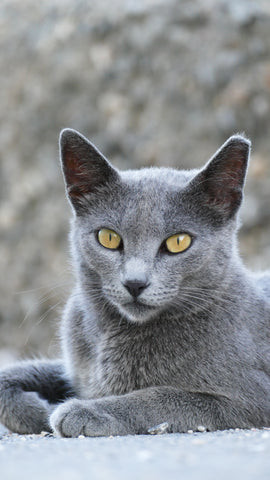 A full-body shot of a sleek grey cat, showcasing its solid, uniform coat color. The cat is standing on a wooden floor, looking directly at the camera with bright green eyes.
A full-body shot of a sleek grey cat, showcasing its solid, uniform coat color. The cat is standing on a wooden floor, looking directly at the camera with bright green eyes.
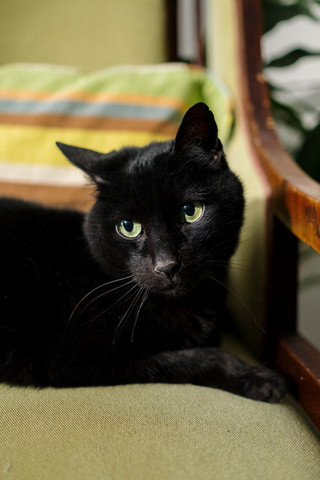 A close-up portrait of a black cat with striking yellow eyes, emphasizing the glossy, solid black fur. The cat is looking slightly to the side, with a plain, dark background.
A close-up portrait of a black cat with striking yellow eyes, emphasizing the glossy, solid black fur. The cat is looking slightly to the side, with a plain, dark background.
While black and orange are the base colors, you’ve surely noticed cats in a wide variety of other solid shades. If all cats start with a black or orange foundation, where do these other colors originate? The answer lies in “dilution genes.” These genes act like filters, modifying the intensity of the base pigments.
Solid-colored cats, excluding white, are all genetically black. However, some possess genes that dilute this black pigment into softer shades. These dilution genes can transform black into colors like brown, blue (gray), lilac, fawn, or cinnamon.
For example, the elegant Russian Blue, known for its silvery coat, is genetically a solid black cat. Its distinctive gray coat is the result of a dilution gene modifying the black pigment. Similarly, the rich chocolate hue of the Havana Brown is achieved through a dilution gene transforming black into brown. In contrast, all-black cats proudly display their unaltered base color, showcasing the “no filter” version of feline colors. Therefore, cats with a single, uniform color are genetically black, with or without the influence of dilution genes. (Solid white cats are an exception and will be discussed later.)
The Curious Case of Solid Orange Cats
Just as black can be diluted to gray, the orange base color can also be diluted, resulting in cream. However, unlike black cats, a truly solid orange or cream cat does not exist naturally. This is because the tabby gene interacts uniquely with orange pigment. The tabby pattern is inherently expressed in orange cats, meaning there are no solid orange cats in the same way there are solid black cats.
While Thomas O’Malley from Disney’s Aristocats is depicted as a solid orange cat, such a feline is a rarity in reality. Except for extremely rare genetic mutations, a cat’s coat cannot be truly solid orange. Orange cats will always exhibit a tabby pattern, even if it’s subtle.
Tabby: The Ubiquitous Pattern in Cat Colors
Now that we understand the base colors and dilution, let’s explore patterns. Beyond color, cats are also categorized as either tabby or non-tabby.
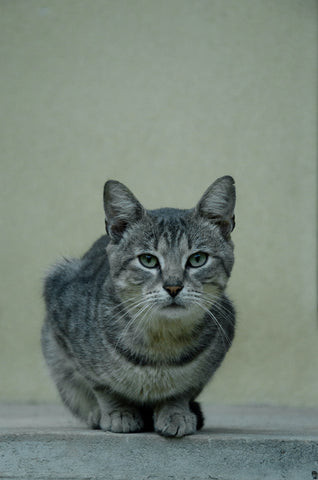 A playful ginger tabby cat lying on its back on a patio, paws in the air, showcasing the classic tabby stripes and orange fur. The cat is in focus, with a blurred background of greenery and patio furniture.
A playful ginger tabby cat lying on its back on a patio, paws in the air, showcasing the classic tabby stripes and orange fur. The cat is in focus, with a blurred background of greenery and patio furniture.
Every cat carries either the “agouti” gene (tabby pattern) or the “non-agouti” gene (no tabby pattern). The agouti gene is dominant, making tabby patterns incredibly common in cats. In fact, one could argue that all cats are genetically predisposed to be tabby. Cats with the non-agouti gene essentially have their tabby pattern “turned off,” masking the underlying pattern.
With just these genetic options – black vs. orange base color, dilution genes, and tabby vs. non-tabby – a remarkable variety of coat colors and patterns becomes possible.
For example, consider a cat with a black base color that is diluted to gray, and also carries the agouti gene. This genetic combination results in a gray tabby cat.
Interestingly, black cats can also carry the agouti gene and be tabby. While often subtle and difficult to see on black fur, the tabby pattern can sometimes be visible, especially in kittens or when sunlight catches the coat at the right angle.
When thinking of tabby cats in popular culture, iconic characters like Garfield or Puss-in-Boots immediately come to mind, both famous for their orange tabby coats.
Even if an orange cat inherits the non-agouti gene, their underlying tabby pattern remains visible. This is because the non-agouti gene only affects black pigment and has no impact on orange pigment. This genetic quirk means that all orange cats are inherently tabby.
Spots & Stripes: Variations in Tabby Patterns
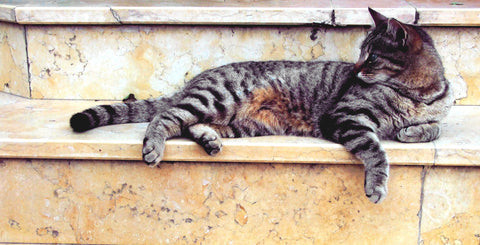 A tabby cat with distinct mackerel stripes, sitting alertly on a wooden surface. The cat is mostly grey with darker stripes, green eyes, and a focused expression, set against a blurred outdoor background.
A tabby cat with distinct mackerel stripes, sitting alertly on a wooden surface. The cat is mostly grey with darker stripes, green eyes, and a focused expression, set against a blurred outdoor background.
Just as dilution genes modify base colors, the agouti gene itself can be further modified, resulting in four distinct types of tabby patterns.
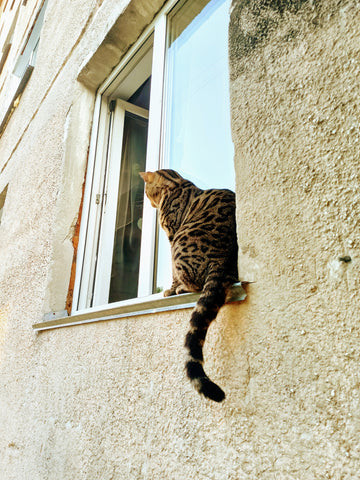 A close-up of a cat's fur, demonstrating the ticked tabby pattern with agouti hairs showing bands of color. The fur is a mix of light and dark shades, creating a subtle, textured appearance.
A close-up of a cat's fur, demonstrating the ticked tabby pattern with agouti hairs showing bands of color. The fur is a mix of light and dark shades, creating a subtle, textured appearance.
The most common tabby pattern is the “mackerel” tabby. This pattern is characterized by vertical stripes along the cat’s sides, resembling the stripes on a mackerel fish, hence the name. It’s the classic “tiger-striped” look most people envision when thinking of a tabby cat.
The second most common tabby pattern is the “classic” or “marbled” tabby. This pattern features swirling, broad stripes and blotches, creating a marbled effect rather than distinct stripes.
 A close-up of a classic tabby cat's side, showing the swirling, marbled pattern of the fur in shades of brown and black. The fur is soft and detailed, with a smooth transition between colors.
A close-up of a classic tabby cat's side, showing the swirling, marbled pattern of the fur in shades of brown and black. The fur is soft and detailed, with a smooth transition between colors.
The “spotted” tabby pattern is often perceived as more exotic due to its resemblance to wild cats like jaguars and leopards. Spotted tabbies have spots instead of stripes or swirls. This pattern is frequently seen in breeds like the Bengal or Savannah Cat, which are domestic breeds intentionally crossbred with wild cat species like servals.
Finally, the “ticked” tabby pattern is the most unique and least obviously tabby. In this pattern, stripes are faint and primarily visible on the head and legs. The body fur appears speckled with individual hairs displaying bands of color, creating a salt-and-pepper effect rather than distinct stripes or spots. The Abyssinian breed is a prime example of the ticked tabby pattern.
Bicolor & Tricolor: Adding White to the Cat Color Palette
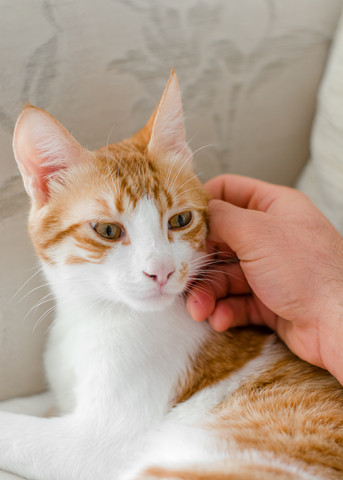 A charming bicolor cat, ginger and white, in a relaxed pose. The cat has patches of orange and white fur, with a predominantly white chest and paws, and is looking directly at the viewer.
A charming bicolor cat, ginger and white, in a relaxed pose. The cat has patches of orange and white fur, with a predominantly white chest and paws, and is looking directly at the viewer.
Now we’ve explored orange, black, tabby patterns, and dilution. The final major genetic element contributing to cat colors is the “masking” gene, which introduces white into the coat.
The masking gene essentially “masks” or covers any underlying color with white. If this gene is expressed only in certain areas of the cat’s body, it’s termed “partial masking” or “piebald,” resulting in bicolor or tricolor patterns. If the masking gene is expressed throughout the entire body, it’s “complete masking,” resulting in an all-white cat.
Piebald Patterns: Bicolors and Tricolors Explained
A bicolor cat displays a coat that is part white and part another color. The colored portions can be any combination of base color (orange or black), dilution, and tabby pattern.
Bicolor patterns are incredibly varied and beautiful. A common bicolor pattern is the “tuxedo” cat, which is predominantly black with white markings typically on the chest, paws, and sometimes face, resembling a tuxedo shirt. Another common pattern is the “locket” pattern, where a cat has a small, distinct patch of white, often on the chest.
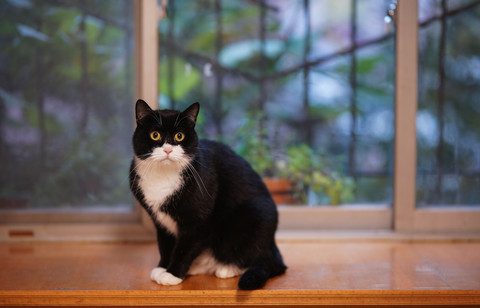 A classic tuxedo cat, black and white, sitting upright and alert. The cat has a black body with a white chest, paws, and chin, resembling a tuxedo, set against a neutral background.
A classic tuxedo cat, black and white, sitting upright and alert. The cat has a black body with a white chest, paws, and chin, resembling a tuxedo, set against a neutral background.
As the name suggests, a tricolor cat exhibits three distinct colors: white, orange, and black. Similar to bicolor cats, the colored sections in tricolor cats can also be diluted or tabby patterned.
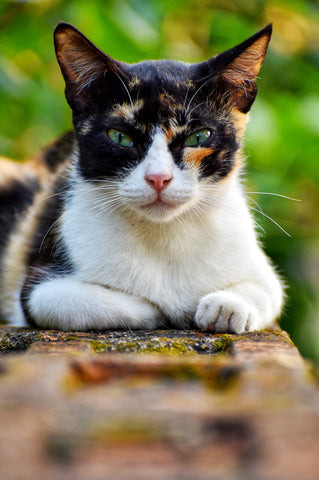 A calico cat with distinct patches of white, black, and orange fur, sitting in a garden setting. The cat is looking to the side, with a mix of fur colors clearly visible, and a natural outdoor background.
A calico cat with distinct patches of white, black, and orange fur, sitting in a garden setting. The cat is looking to the side, with a mix of fur colors clearly visible, and a natural outdoor background.
As we learned earlier, only female cats can naturally be both orange and black. Consequently, tricolor cats are almost exclusively female. Tricolor cats are commonly known as calico cats.
It’s easy to confuse tortoiseshell and calico cats. A tortoiseshell cat is any cat with both orange and black in their coat, while a calico cat specifically has orange, black, and white. Therefore, all calico cats are technically tortoiseshells, but not all tortoiseshells are calico.
Snowball Cats: Distinguishing Albino from White
A common misconception is that all-white animals are albino. However, most white cats are not true albinos. So, what differentiates a truly albino cat from a white cat?
A true albino cat has albinism, a genetic condition that prevents the body from producing melanin, the pigment responsible for color in skin, fur, and eyes. This occurs regardless of the cat’s underlying color genes. An albino cat might genetically be programmed to be orange, black, or any pattern, but due to the inability to produce pigment, these genes are not expressed in color.
Think of it like a paint-by-numbers kit. Even if the instructions specify blue, red, or green, if you have no paint, the picture remains uncolored.
Albino cats may have increased sensitivity to sunlight and potentially some health challenges, but they are otherwise normal cats and wonderful companions.
 An albino cat with pure white fur and striking pink eyes, sitting on a soft blanket. The cat's features are highlighted by the contrast of its white fur against the slightly darker blanket.
An albino cat with pure white fur and striking pink eyes, sitting on a soft blanket. The cat's features are highlighted by the contrast of its white fur against the slightly darker blanket.
True albinism in cats is extremely rare. Most white cats are white due to the masking gene, not albinism. These white cats have the same masking gene that creates white patches in bicolor and tricolor cats, but in their case, it’s expressed over their entire body, overriding all other color genes.
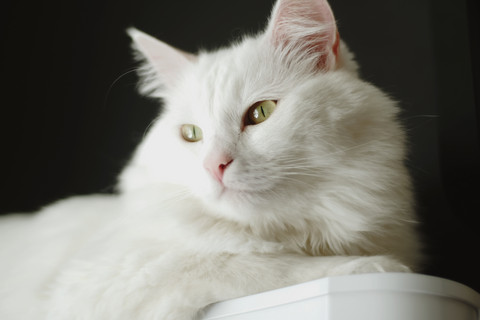 A fluffy white cat with striking blue eyes, sitting regally on a windowsill. The cat's fur is pure white, contrasting with its blue eyes and the window frame, creating a bright and clean image.
A fluffy white cat with striking blue eyes, sitting regally on a windowsill. The cat's fur is pure white, contrasting with its blue eyes and the window frame, creating a bright and clean image.
Returning to our paint-by-numbers analogy, imagine instructions that tell you to paint the entire canvas white, perhaps for a snowy scene. In this case, the cat’s genes are instructing it to be white, unlike albinism where the body cannot produce any color.
How can you tell if a white cat is albino or simply white due to the masking gene? There’s a simple way to distinguish them. If a white cat has any color on their skin, such as black spots on their paw pads, or any color in their eyes, such as yellow or green, it’s not a true albino. These cats are simply white due to the masking gene. A true albino cat will have entirely pink skin and pink or pale blue eyes due to the complete absence of pigment.
Point Patterns: Temperature-Sensitive Colors in Cat Colors
Beyond the masking gene, there’s another way cats can have white fur – the point pattern, a fascinating and almost unbelievable genetic phenomenon.
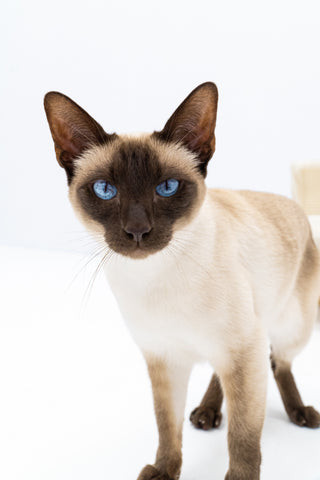 A Siamese cat with a cream-colored body and dark brown points on the ears, face, paws, and tail. The cat has striking blue eyes and a sleek coat, sitting in a relaxed pose.
A Siamese cat with a cream-colored body and dark brown points on the ears, face, paws, and tail. The cat has striking blue eyes and a sleek coat, sitting in a relaxed pose.
The “point” pattern is characterized by a light-colored body with darker extremities – the face, ears, legs, and tail. This pattern is most prevalent in Oriental cat breeds such as Siamese, Tonkinese, Burmese, Himalayan, and related breeds like Ragdoll and Snowshoe.
 A Birman cat with a pale body and darker points, along with distinctive white paws. The cat is sitting comfortably, showcasing its blue eyes and the contrast between its body and point colors.
A Birman cat with a pale body and darker points, along with distinctive white paws. The cat is sitting comfortably, showcasing its blue eyes and the contrast between its body and point colors.
Intriguingly, the white sections in a point pattern are not due to the typical masking gene. Instead, it’s a form of temperature-sensitive albinism!
In cats with the point pattern, the gene controlling pigment production is sensitive to temperature. Warmer areas of the cat’s body are unable to produce pigment. This is why only the cooler extremities develop color. This temperature sensitivity also explains why point-patterned cats typically have blue eyes.
Kittens with the point pattern are born almost entirely white. Their characteristic points develop color gradually over a few weeks as the cooler areas of their body produce pigment. Remarkably, if kittens with this gene are raised in a consistently warm environment during those crucial weeks, they may not develop any points and essentially become all-white, resembling albinos!
Does Coat Color Influence Cat Personality?
Popular anecdotes and stereotypes often link a cat’s coat color to its personality. For example, orange cats are often perceived as lovable but dim-witted, while tortoiseshell cats are rumored to have “tortitude,” a feisty and independent temperament.
However, these stereotypes are likely human projections. The association might arise from the fact that tortoiseshell cats are almost always female, and orange cats are predominantly male. We might subconsciously project gender stereotypes onto these colors, expecting females to be sassy and males to be goofy.
The scientific consensus is that cat coat color is not linked to personality. While cat breeds can influence personality traits (Siamese cats are known for being vocal, Maine Coons for being gentle giants), coat color alone is not a reliable indicator of a cat’s temperament. Whether a kitten grows up to be playful or calm, curious or cautious, cuddly or independent is not predetermined by their coat color. Remember, every cat is an individual with a unique personality.
Cat coat colors are as diverse and individual as the personalities of our feline companions. The vast array of patterns and shades seems to span the entire rainbow, yet it all originates from just two base colors! A few genetic tweaks and filters are all it takes to create the breathtaking variety we see in the colors of cats.
So, the next time you’re petting your purring cat, take a closer look at the intricate patterns in their fur. Take a moment to appreciate the incredible number of beautiful combinations nature has crafted and how truly amazing our feline friends are!

